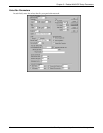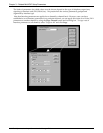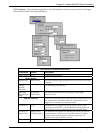
Chapter 3 – Related MultiVOIP Setup Parameters
40 Multi-Tech Systems, Inc. Avaya Communication Manager Guide
Voice/Fax Parameter Definitions Continued
Field
Name
Values Description
AutoCall/Offhook
Alert Parameters
Auto
Call /
Offhook
Alert
AutoCall,
Offhook
Alert
The AutoCall option enables the local MultiVOIP to place a call without the user
having to dial a number. As soon as you access the local MultiVOIP voice/fax
channel, the MultiVOIP immediately connects to the remote endpoint identified
in the Phone Number box of this option.
If the “Pass Through Enable” field is checked in the Interface Parameters screen,
AutoCall must be used.
The Offhook Alert option applies only to FXS channels.
The Offhook Alert option works like this: if a phone goes offhook and no
number is dialed within a specific period of time (as set in the Offhook Alert
Timer field), then that phone will automatically dial the Alert phone number for
the voip channel. (The Alert phone number must be set in the Voice/Fax
Parameters | Phone Number field). One use of this feature would be for
emergency use where a user goes off hook but does not dial, possibly indicating
a crisis situation. The Offhook Alert feature uses the Intercept Tone, as listed in
the Regional Parameters screen. This tone will be output on the phone that was
taken off hook but that did not dial. The other end of the connection will hear
audio from the “crisis” end as it would during a normal phone call.
Both functions apply on a channel-by-channel basis. It would not be appropriate
for either of these functions to be applied to a channel that serves in a pool of
available channels for general phone traffic.
Generate
Local
Dial
Tone
Y/N
Used for AutoCall only. If selected, dial tone will be generated locally while the
call is being established between gateways. The capability to generate dial tone
locally would be particularly useful when there is a lengthy network delay.
Offhook
Alert
Timer
0 – 3000
seconds
The length of time that must elapse before the offhook alert is triggered and a call
is automatically made to the phone number listed in the Phone Number field.
Phone
Number
-- Phone number used for Auto Call function or Offhook Alert Timer function.
Dynamic Jitter
Dynamic
Jitter
Buffer
Dynamic Jitter defines a minimum and a maximum jitter value for voice
communications. When receiving voice packets from a remote
MultiVOIP, varying delays between packets may occur due to network
traffic problems. This is called Jitter. To compensate, the MultiVOIP uses
a Dynamic Jitter Buffer. The Jitter Buffer enables the MultiVOIP to wait
for delayed voice packets by automatically adjusting the length of the
Jitter Buffer between configurable minimum and maximum values. An
Optimization Factor adjustment controls how quickly the length of the
Jitter Buffer is increased when jitter increases on the network. The length
of the jitter buffer directly effects the voice delay between
MultiVOIP
gateways.


















